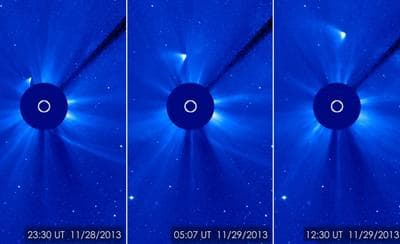Advertisement
Did Comet ISON Fly Too Close To The Sun?
Resume
Kelly Beatty, Sky and Telescopes's senior contributing editor, joins Here & Now's Meghna Chakrabarti with the latest on the path of Comet ISON. The comet at first seemed to have fallen apart as it approached the sun's sizzling surface, but new images today show a streak of light that some say could indicate it's not game over just yet.
U.S. Navy solar researcher Karl Battams writes on his blog that "it does appear that at least some small fraction of ISON has remained in one piece."
He cautions that even if there is a solid nucleus, it may not survive for long. The European Space Agency, which had declared ISON's death on Twitter late Thursday, is now backtracking, saying the comet "continues to surprise."
Guest
- Kelly Beatty, senior contributing editor for Sky & Telescope magazine. He tweets @NightSkyGuy.
This segment aired on November 29, 2013.